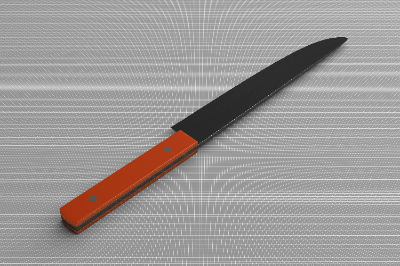What Is Zirconia?

Zirconia is the generic name for zirconium oxide, an oxide of zirconium.
Its chemical formula is ZrO2, and it is classified as a ceramic. Its extremely high melting point and heat resistance make it suitable as a raw material for cutting and polishing tools and refractories. Zirconia is also used in dental materials and ceramic knives as a familiar example.
Uses of Zirconia
Zirconia has a high melting point and is resistant to chemical erosion, making it suitable as a material for cutting and polishing tools and refractories such as crucibles and furnaces. Zirconia is also used in ceramic knives because of its hardness, flexibility, and strength.
Among zirconia materials, tetragonal zirconia is used as a raw material for ceramics and as grinding balls for electronic components.
Cubic zirconia also has oxygen ion conductivity and is used as a solid electrolyte membrane in fuel cells.
Principles of Zirconia
Zirconium is an element with atomic number 40, and its oxide, zirconium oxide, is called zirconia and classified as a ceramic. At room temperature, it forms the most stable monoclinic crystal structure, but as the temperature is increased, the material changes sequentially to tetragonal and cubic crystals.
Properties of Zirconias
Zirconia (ZrO2) has a melting point of about 2,700°C. It has many features such as low thermal conductivity, heat resistance, corrosion resistance, and high strength. On the other hand, zirconia is susceptible to degradation due to changes in crystal structure and volume caused by changes in temperature.
Oxides such as yttrium oxide (Y2O3), calcium oxide (CaO), cerium oxide (CeO2), and magnesium oxide (MgO) are suitable stabilizers for zirconia. By adding these oxides to react and form a solid solution in the crystal structure, the stable existence of cubic crystals at room temperature becomes possible. Zirconia with a stable cubic crystal at room temperature is called stabilized zirconia or partially stabilized zirconia.
1. Stabilized Zirconia
Stabilized zirconia is a good conductor of oxygen ions at high temperatures due to its high oxygen vacancy lattice. It is also chemically stable and is being investigated as a solidification base material for high concentration TRU waste.
2. Partially stabilized Zirconia
Partially stabilized Zirconia is generally made by reducing the amount of oxide added compared to stabilized zirconia.
Other Information on Zirconia
1. Dental Applications of Zirconia Ceramics
When 3 mol% yttrium oxide is added to partially stabilized zirconia, Y-TZP (Tetragonal Zirconia Polycrystal), which has almost 100% tetragonal crystals at room temperature, is used as a dental material. Zirconia is a highly hard material, which makes it less workable when fully sintered.
For this reason, zirconia products used for dental applications are generally made by cutting blocks in a semi-sintered state, which is relatively easy to process, followed by full sintering.
2. Zirconia manufacturing method
There are two main methods of zirconia production: wet refining and dry refining. The raw materials for both methods are zirconium ores such as zircon and adelite. The first process in the wet refining method is to melt the selected ores with caustic soda, and then decompose. After further processes such as washing and filtration, the resulting zirconium hydroxide is calcined and pulverized to produce zirconia powder. In the dry refining method, on the other hand, the ore is crushed to remove impurities and then beneficiated repeatedly to produce pure zirconia.
3. The difference between Zirconia and metals
The difference between zirconia and metals is that zirconia is an oxide of zirconium metal, which is a ceramic due to covalent bonds stronger than metallic bonds.
- Resistance to corrosion
Metals tend to combine with corrosive elements in the environment, such as oxygen and sulfur, and corrode relatively easily, but zirconium rarely corrodes. - High hardness and heat resistance
Zirconium is formed by covalent bonds that are stronger than metallic bonds, making it extremely hard, strong, and difficult to deform, and its high melting point (1,855°C) also makes it highly heat resistant.
On the other hand, unlike metals, zirconia is not ductile and does not elongate, making it vulnerable to strong impacts, and in some cases, it may crack.
4. Difference between Zirconia and Silica ceramics
Zirconia has become widely used in dentistry in recent years, as mentioned above, because of its hardness, flexibility, and non-corrosive properties compared to metals. However, silica-based ceramics have the disadvantage of being hard but easily fractured when compared to real teeth.
Zirconia is so hard that it is called an artificial diamond, and its hardness is about 10 times that of conventional ceramics, making it extremely durable. However, in recent years, the variations have increased, and in dental applications, it is also being used in front teeth, which requires a high level of aesthetics in dental applications.
5. Disadvantages of Zirconia in dental applications
Although dental zirconia is white in color and esthetic, it is less transparent than silica ceramics, and the lack of color variation has been considered a demerit. Recently, however, the number of variations has increased, and zirconia is now being used for anterior teeth, which requires a high level of aesthetics in dental applications.
However, zirconia is extremely hard, about 10 times harder than ceramics, and if the bite is incorrectly adjusted, it can shave the teeth to which it is being meshed, which is a demerit that needs to be improved. In addition, to its hardness of zirconia, it makes it difficult to process and shape manually by dentists, and because it is shaped by a computerized machine, it is less precise than ceramics.
Finally, another disadvantage is the high cost of treatment. This is due to the high price of high-quality zirconia itself used in dentistry and the fact that it is an out-of-pocket treatment not covered by insurance, but this is a point that should be improved in the future.